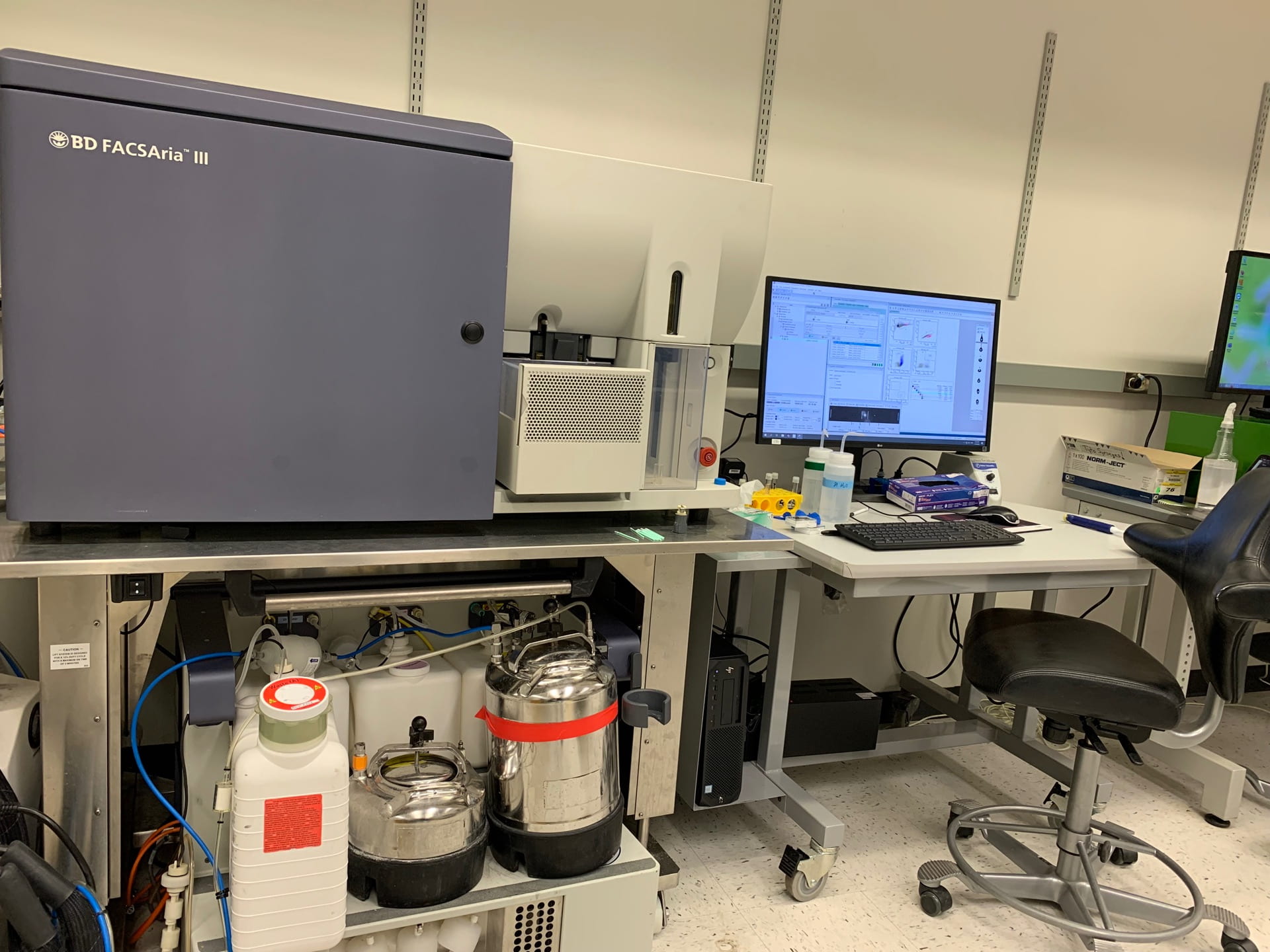The restoration work on the AriaIII is now complete! As I’m writing this, I’m performing the very first experiment this instrument has seen in over five years. It took a lot of effort to get here, and I wanted to share how everything went down, and why we made some of the decisions that we did.
The context in which we acquired the instrument was one where we were having increasingly difficult issues with our other platform, the AriaIIIu. The computer had crashed, and so did the YG laser. It also had some pressure issues that we never got around to. On top of that, we had starting using parts of the AriaIIIu to repair the other working cell sorters. Knowing that an AriaIII was around on campus, unused, we decided to reach out to the department owning the instrument to see if we could get it off their hands. They graciously accepted, in exchange for getting that thing out of the BSL3 lab where it was confined. The whole staff got involved and I have never sweated this much while at work, under all those layers of PPE.
The question then became what do we salvage: a rusting but beloved AriaIIIu, or an AriaIII which has not been used in many moons. Flow cytometers do not like to remain idle, so we were expecting quite a few issues with this new instrument. But in the end, it made more sense to retire the AriaIIIu – a 16-year old sorter.
Why not keep both? It’s a capacity thing. Most of the time, having three sorters here is enough. It I don’t believe we have enough demand to support all five sorters (had we decided to keep the AriaIIIu). Secondly, we needed to cannibalize the AriaIIIu to keep the cost of restoration as low as possible. In a sense, the AriaIIIu and the AriaIII were merged into a new instrument that we will now call the AriaIII.

The AriaIII is a 3 lasers sorter capable of handling up to 14 fluorescent parameters from a sample. No plate sort here, and no 561nm laser either.
So what did we do exactly? Firstly, I wanted the instrument to be upgraded. It was initially a 3 lasers / 8 parameters cell sorter. We got our BD FSE to install an additional detectors to accommodate more complex panels. We decided against adding a 561nm line because it’s expensive, and mostly used for fluorescent proteins excitation. On one hand, we have three other sorters that can do that. But also, BD announced that the AriaII support will end in 2024, and I’m expecting the AriaIII to follow suit shortly after. So I’m not that interested in upgrading mid-to-end of life platforms.
Secondly, we had to scrub the fluidics and replace several valves, as well as the flow cell. If you do not shut down an instrument properly, the salt deposit that develops as the fluidic lines dry out will cause problems when you turn back on the system. (À propos, here’s a list of shutdown protocols that we gathered).
Finally, the computer had to be replaced. We had the same issue on the AriaIIIu, but almost immediately after building a new computer it could utilize, we lost it to a computer virus (read about that story, minus the sad ending here). Both computers on the AriaIIIu and AriaIII were running on Windows XP, and from then on we could not manage to 1 – create a new XP machine that would 2 – talk to either of the Aria units. We lost quite a bit of time on this problem, and finally decided to bite the bullet and spend money on a Windows 10 computer upgrade offered by BD.
This upgrade was a difficult and long process. We had various issues with the computers that were sent our way and had to wait to the 4th computer to get the instrument going. It’s unclear where those issues were stemming from, but they included no connection with the instrument cameras, constant crashing, monitor display problems (where the monitor wouldn’t display anything). I’ll spare you the details, I think quite a bit of it was due to these COVID years, but we finally got through everything. A few nagging issues remain – mainly due to the beefed up security features added by BD to their machines. Notably, they prevent access to the BD Service account without 2-step identification system (essentially you can’t get access to it without a BD special approval, which is annoying). These features also get in the way of our data transfer system here on campus, and we’re down to transfer the data on a external drive¹. The ignominy. Overall, I don’t think I can recommend this computer upgrade. I probably would have found a way around it if not for the fact that there were none.
This is where we stand at this point. The AriaIII will hopefully be with us for a while. With the arrival of the Bigfoot in 2021 and the Tyto in 2020, we now have 5 cell sorting platforms available in the CAT Facility. We’ll be looking for ways to replace other aging instruments in the coming years, notably the AriaII which willl no longer be supported by BD starting in 2024. On that note, get in touch with us if you like a specific instrument on the market, we’ll see if we can organize a demo!
Note
¹ The BD people resolved this issue recently, they had to essentially run a script that scrubbed all the security features added to this new computer. Without knowing exactly what caused the issue, the data is now moving normally to the server.
Learn more about our Cell Sorting Service and our newest platforms

Cells Sorters
Learn more about all CAT Facility sorters

Bigfoot
Droplet-Based Sorter Traditional and spectral capabilities

MACSQuant Tyto
Mechanical Sorter


0 Comments